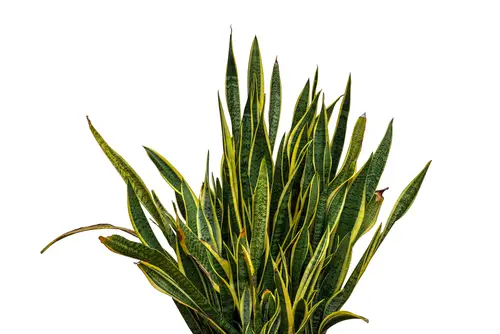Snake plants are a popular choice for indoor gardening due to their low-maintenance nature and air-purifying qualities. However, even the most experienced plant owners may encounter issues with their snake plants, such as drooping leaves.
Understanding the common causes of snake plant drooping and how to address them can help owners revive their beloved plants.
One of the most common causes of snake plant drooping is overwatering. Snake plants are drought-tolerant and do not require frequent watering. In fact, overwatering can lead to root rot and cause the plant to droop.
On the other hand, underwatering can also cause drooping leaves. Proper soil and drainage, as well as monitoring the plant’s water needs, can help prevent overwatering and underwatering.
Key Takeaways
- Overwatering and underwatering are common causes of snake plant drooping.
- Proper soil and drainage are essential for snake plant care.
- The role of light and temperature, as well as dealing with pests and diseases, can also impact a snake plant’s health.
More on this category:
Understanding Snake Plant
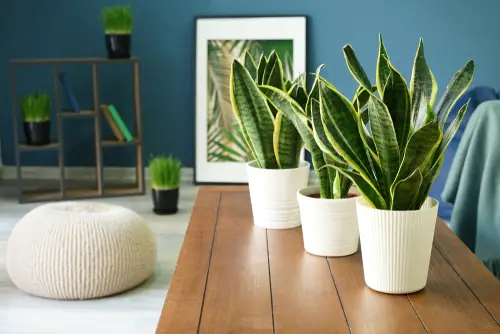
Snake plant, also known as Sansevieria or mother-in-law’s tongue, is a popular houseplant known for its upright leaves and low maintenance. It belongs to the family Asparagaceae and is native to West Africa.
Snake plants are versatile and can thrive in a variety of indoor conditions. They can tolerate low light and infrequent watering, making them an ideal plant for beginners or those with busy lifestyles.
The leaves of the snake plant are long and narrow, with a pointed tip and a dark green color. Some varieties have yellow or white variegation, adding a decorative touch to the plant.
In addition to its aesthetic appeal, snake plants are also known for their air-purifying properties. They can remove toxins such as formaldehyde, benzene, and xylene from the air, making them a valuable addition to any indoor space.
Snake Plant Care Requirements
Snake plants are easy to care for and can thrive in a variety of environments. However, to prevent drooping, it is important to ensure that the plant’s basic needs are met. Here are some snake plant care requirements to keep in mind:
1. Watering Schedule
Snake plants do not require frequent watering. In fact, overwatering can lead to root rot and drooping. It is recommended to water the plant once every two to three weeks. Before watering, make sure the soil is dry to the touch.
2. Lighting
Snake plants can tolerate a wide range of lighting conditions, from partial sun to bright, indirect light. However, they do best in bright, indirect light. Avoid placing the plant in direct sunlight, especially if it is in a south-facing window, as this can scorch the leaves.
3. Temperature and Humidity

Snake plants are tolerant of a wide range of temperatures and humidity levels. They can tolerate temperatures as low as 50°F (10°C) and as high as 85°F (29°C). However, they prefer temperatures between 60°F (16°C) and 75°F (24°C). They also do not require high humidity levels and can tolerate dry indoor environments.
4. Soil Requirements
Snake plants prefer well-draining soil. It is important to ensure that the soil is not too compact and has adequate drainage. A good soil mix for snake plants is a combination of potting soil, sand, and perlite.
5. Photosynthesis
Snake plants require photosynthesis to survive. Photosynthesis is the process by which plants convert light energy into chemical energy. It is important to ensure that the plant receives adequate light to carry out this process.
By following these basic care requirements, you can help prevent drooping and ensure that your snake plant remains healthy and vibrant.
Why Snake Plants Droop – 6 Common Problems
Snake plants are known for their hardiness and resilience, but they can still experience drooping or wilting leaves. Here are some common causes of drooping in snake plants:
1. Overwatering
Overwatering is one of the most common causes of drooping in snake plants. When soil is consistently wet, it can lead to root rot, which can cause the leaves to droop and turn yellow. It’s important to let the soil dry out between waterings and ensure that the pot has adequate drainage.
2. Underwatering
Underwatering can also cause snake plant leaves to droop. When the soil is too dry, the plant can’t absorb enough water to support the leaves. This can cause them to wilt and become limp. It’s important to water your snake plant regularly and ensure that the soil is moist but not waterlogged.
3. Poor Lighting

Snake plants require bright, indirect light to thrive. If they are kept in low light conditions, their leaves may droop and become weak. It’s important to place your snake plant near a window where it can receive adequate light, but not direct sunlight.
4. Poor Drainage
Poor drainage can also cause snake plant leaves to droop. If the pot doesn’t have adequate drainage holes, water can accumulate in the soil and cause root rot. It’s important to ensure that your snake plant is planted in a pot with drainage holes and that excess water can drain away.
5. Disease and Pests
Disease and pests can also cause snake plant leaves to droop. Common pests that can affect snake plants include spider mites and mealybugs. Fungal diseases can also cause the leaves to droop and turn yellow. It’s important to inspect your snake plant regularly for signs of pests or disease and take appropriate action if necessary.
6. Neglect
Neglect can also cause snake plant leaves to droop. If the plant is not receiving adequate water, light, or nutrients, it can become weak and droopy. It’s important to care for your snake plant regularly and ensure that it is receiving the proper care and attention it needs to thrive.
Overwatering and Underwatering: Signs and Solutions
Snake plants are resilient and can withstand a range of conditions, but overwatering and underwatering can cause them to droop. It is important to understand the signs of overwatering and underwatering, as well as the solutions for each.
Overwatering Symptoms and Remedies
Overwatering is one of the most common causes of snake plant drooping. When the soil is constantly moist, the roots can rot, and the plant cannot absorb nutrients properly. Here are some signs of an overwatered snake plant and the remedies:
- Moldy soil: If the soil of your snake plant remains moist for an extended period, it can develop mold. This mold can appear white, green, or black and can damage the plant’s roots. To remedy this, remove the plant from its pot, remove the affected soil, and repot the plant using fresh soil.
- Drooping leaves: Overwatering can cause the leaves of the snake plant to droop and become soft. To remedy this, allow the soil to dry out completely before watering again. Ensure that the pot has proper drainage and that the plant is not sitting in water.
- Yellow leaves: Overwatering can cause the leaves of the snake plant to turn yellow. To remedy this, cut off any yellow leaves and adjust the watering schedule to once every two to four weeks.
Underwatering Symptoms and Remedies
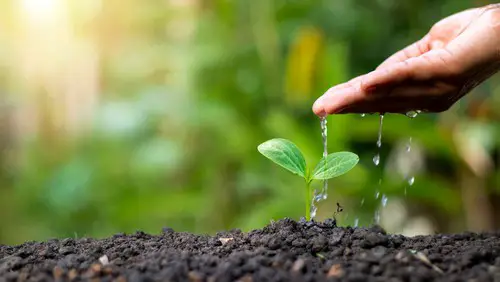
Underwatering is another common cause of snake plant drooping. When the soil is too dry, the plant cannot absorb enough water, and the leaves become limp. Here are some signs of an underwatered snake plant and the remedies:
- Dry soil: If the soil of your snake plant is dry to the touch, it is underwatered. To remedy this, water the plant thoroughly until water runs out of the drainage holes. Ensure that the top three inches of soil are moist.
- Curling leaves: Underwatering can cause the leaves of the snake plant to curl inward. To remedy this, water the plant more frequently, every three to five years.
- Slow growth: Underwatering can cause the snake plant to grow slowly. To remedy this, water the plant more frequently and ensure that it is receiving enough sunlight.
Proper Soil and Drainage for Snake Plants
Snake plants are known for their hardiness and ability to withstand a variety of growing conditions. However, one of the most common reasons for snake plant drooping is inadequate soil and drainage.
Snake plants prefer well-draining soil that is not too compact. Soil that is too dense can retain too much water, leading to root rot and drooping leaves. To ensure proper drainage, it is essential to plant snake plants in containers with drainage holes.
When selecting soil for snake plants, it is best to choose a well-draining potting mix that is specifically formulated for succulents and cacti. These mixes typically contain a combination of perlite, sand, and compost, which provide excellent drainage while also retaining enough moisture to keep the plant healthy.
If you are unsure whether your soil is providing adequate drainage, you can perform a simple test. Water your snake plant thoroughly and wait a few minutes. Then, gently tilt the pot to one side and see if any excess water drains out of the bottom.
If the soil is too dense and does not allow for proper drainage, you may need to repot the plant in a more suitable mix.
The Role of Light and Temperature

Snake plants require adequate light and temperature conditions to thrive. They are tolerant of low light conditions, but they will grow best in bright, indirect light. If the plant is not getting enough light, it may become weak and droop.
On the other hand, if it is exposed to too much direct sunlight, the leaves may become scorched and turn yellow.
Temperature is also an important factor to consider when caring for a snake plant. They prefer warm temperatures above 50°F and can be sensitive to sudden temperature changes. If the plant is placed near a heat source such as a radiator, it may become too dry and droop.
In general, snake plants can tolerate a wide range of temperatures, but they should be kept away from cold drafts and extreme temperature fluctuations. If the plant is exposed to cold temperatures, the leaves may become discolored and droop.
To maintain healthy growth, it is essential to provide your snake plant with consistent light and temperature conditions. If the plant is not thriving, it may be necessary to adjust its environment to ensure that it is getting the right amount of light and warmth.
Dealing with Pests and Diseases
Snake plants are generally hardy and resistant to pests and diseases. However, they can still be susceptible to certain issues, especially if they are not properly cared for. Here are some common pests and diseases that can cause snake plant drooping and how to deal with them.
1. Pest Infestation
One of the most common pests that can affect snake plants is spider mites. These tiny pests can cause webbing on the plant and can cause leaves to turn yellow and fall off. To deal with spider mites, it is recommended to use neem oil. Neem oil is a natural insecticide that is safe for plants and can effectively kill spider mites.
Another common pest that can affect snake plants is mealybugs. These pests can cause a white, cottony substance to appear on the plant and can cause leaves to droop.
To deal with mealybugs, it is recommended to use a solution of hydrogen peroxide and water. This solution can effectively kill mealybugs and prevent further infestations.
2. Disease Issues
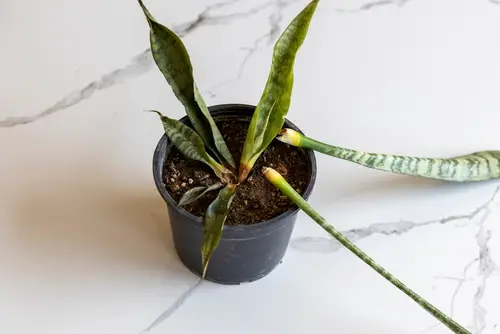
Root rot is a common disease that can affect snake plants. This disease is caused by overwatering and can cause roots to become mushy, leading to drooping leaves and eventual death of the plant. To prevent root rot, it is important to ensure that the soil is well-draining and that the plant is not overwatered.
Another disease that can affect snake plants is fungal leaf spot. This disease can cause brown spots to appear on the leaves and can cause them to droop. To deal with fungal leaf spot, it is recommended to remove any affected leaves and to ensure that the plant is not overwatered.
3. Neem Oil
Neem oil is a natural insecticide that can effectively kill pests such as spider mites and mealybugs. It is safe for plants and can be used as a preventative measure to prevent infestations.
4. Hydrogen Peroxide
Hydrogen peroxide can be used to kill mealybugs and prevent further infestations. It can also be used to prevent fungal leaf spot by sterilizing the soil and preventing the growth of fungi.
Repotting a Drooping Snake Plant
If a snake plant is drooping, it may be time to repot it. Repotting a snake plant can help it recover from issues like root rot, girdling, and being root-bound.
When repotting a drooping snake plant, the first step is to carefully remove it from its current pot. If the plant is root-bound, you may need to use scissors or a knife to cut away some of the bound roots. Be sure to remove any dead or damaged roots as well.
Next, examine the root ball and gently tease the roots apart. This will help the plant establish new roots in the fresh soil. If the root ball is very compacted, you may need to use your fingers to loosen it up.
Choose a new pot that is slightly larger than the old one, with drainage holes in the bottom. Fill the bottom of the pot with a layer of gravel or small stones to improve drainage. Then, add fresh potting soil to the pot.
Place the snake plant in the new pot, making sure that the top of the root ball is level with the soil surface. Add more soil around the plant, pressing it down gently to remove air pockets.
Water the plant thoroughly, allowing the excess water to drain out of the bottom of the pot. Be sure to empty the saucer or tray underneath the pot to prevent the plant from sitting in standing water.
With proper care, a repotted snake plant should recover from drooping and thrive in its new pot.
Reviving a Neglected Snake Plant

If your snake plant is looking weak or unhealthy, there are steps you can take to revive it. Neglected snake plants may droop or start to yellow, but with some care and attention, they can recover.
1. Watering
One common cause of a drooping snake plant is lack of water. While snake plants don’t need to be watered frequently, they do need adequate water to thrive. If the soil stays dry for more than a few weeks, your snake plant may begin to droop or even start to fall over.
To revive a neglected snake plant, the first step is to water it properly. Make sure the soil is moist, but not waterlogged. Water the plant deeply, allowing the water to drain out of the bottom of the pot. Don’t let the plant sit in standing water, as this can lead to root rot.
2. Soil
Another cause of a drooping snake plant is inadequate soil and drainage. Snake plants need well-draining soil to thrive, and if the soil is holding too much water, it can lead to root rot.
To revive a neglected snake plant, you may need to repot it in fresh soil. Use a soil mix that is specifically formulated for succulents or cacti, or add perlite or sand to a regular potting mix to improve drainage.
3. Nutrients
Snake plants don’t need to be fertilized frequently, but they do need some nutrients to stay healthy. If your snake plant is looking weak or unhealthy, it may be lacking in nutrients.
To revive a neglected snake plant, you can fertilize it with a balanced fertilizer once every few months during the growing season. Be careful not to over-fertilize, as this can lead to burning the roots.
4. Winter Months
During the winter months, snake plants may go dormant and require less water and fertilizer. If your snake plant is looking weak or unhealthy during the winter, it may just be going through a natural dormancy period.
Reduce watering and fertilizing during the winter months, and wait until the plant starts to show new growth in the spring before resuming regular care.
5. Yellowing Leaves
If your snake plant’s leaves are turning yellow, it may be a sign of overwatering or root rot. To revive a neglected snake plant with yellowing leaves, you may need to repot it in fresh soil with better drainage.
Cut away any yellow or brown leaves, as these are unlikely to recover. Wait until the plant shows new growth before resuming regular watering and fertilizing.
Conclusion
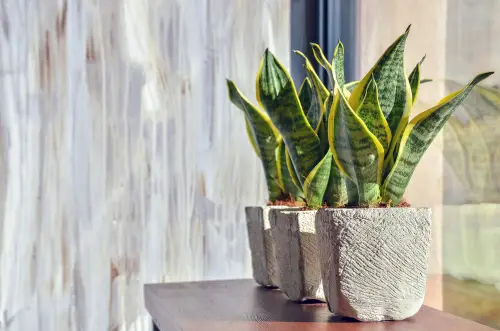
Reviving a neglected snake plant may take some time and effort, but with proper care and attention, it can recover and thrive. Make sure to water the plant properly, use well-draining soil, and fertilize it occasionally.
If your snake plant is going through a natural dormancy period, reduce watering and fertilizing during the winter months. If the leaves are turning yellow, repot the plant in fresh soil with better drainage and cut away any damaged leaves.
Frequently Asked Questions
How can I fix drooping leaves on my snake plant?
Drooping leaves on a snake plant can be caused by a variety of factors, including overwatering, underwatering, lack of sunlight, and poor soil drainage.
To fix drooping leaves, it’s important to identify the underlying cause and take appropriate action. For example, if the plant is overwatered, reduce watering frequency and ensure proper soil drainage.
If the plant is underwatered, increase watering frequency and ensure the soil is thoroughly moistened.
Is cutting off drooping leaves the best solution for a snake plant?
Cutting off drooping leaves is not always the best solution for a snake plant. While removing dead or damaged leaves can improve the plant’s appearance, cutting off healthy leaves can harm the plant and stunt its growth.
Instead of cutting off drooping leaves, it’s better to identify and address the underlying cause of the drooping.
What causes snake plant leaves to turn yellow and wilt?
Yellowing and wilting leaves on a snake plant can be caused by overwatering, underwatering, or exposure to extreme temperatures. In some cases, yellowing leaves may also be a sign of a pest infestation or disease.
To prevent yellowing and wilting, it’s important to ensure proper soil drainage, avoid overwatering, and keep the plant in a moderate temperature range.
Why are my snake plant leaves curling and drooping?
Curling and drooping leaves on a snake plant can be caused by a lack of water, exposure to extreme temperatures, or pest infestations.
To address curling and drooping leaves, it’s important to ensure proper watering and temperature conditions, and to inspect the plant for signs of pests or disease.
Are there any tips for reviving a droopy snake plant after repotting?
To revive a droopy snake plant after repotting, it’s important to ensure proper soil drainage and watering. After repotting, wait a few days before watering the plant to allow it to adjust to its new environment. When watering, ensure that the soil is thoroughly moistened but not waterlogged.
How can I tell if my snake plant is overwatered and what should I do about it?
Overwatering can cause a snake plant’s leaves to turn yellow and wilt, and the soil may feel consistently damp or waterlogged. To address overwatering, reduce watering frequency and ensure proper soil drainage. It may also be helpful to repot the plant in fresh, well-draining soil.

Hey, I’m Lisa and I’ve been an avid gardener for over 30 years. I love writing, talking and living in the garden! Feel free to connect with me on my socials below

